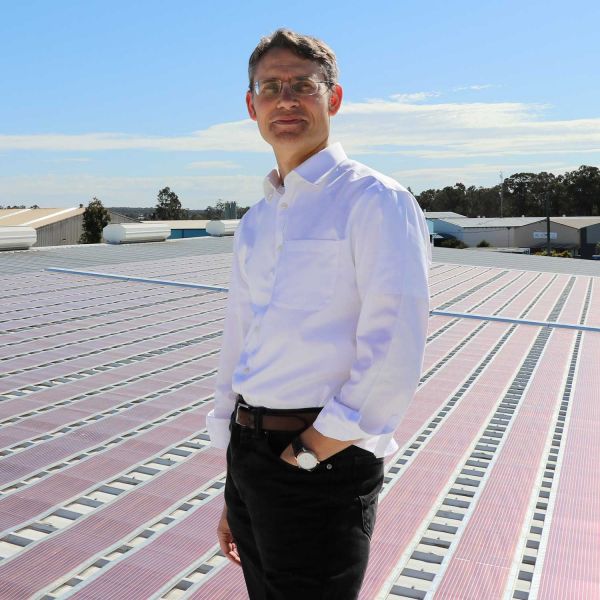Printed Solar Cells - Electric partnership powers energy innovation
With Australia’s energy crisis dominating news headlines, a powerful new industry-research collaboration is signaling the emergence of a new renewable energy market – organic printed solar.

Professor Paul Dastoor
Created by University of Newcastle Physicist, Professor Paul Dastoor, organic printed solar cells are electronic inks printed onto sub-millimetre thin plastic sheets using conventional printers. CHEP, a Brambles company, has become their historic first commercial partner helping to explore the potential of the technology.
“This is the first commercial uptake of printed solar in Australia, most likely the world. It’s an historic step in the evolution of this technology and another example of private enterprise and community leading the charge in the adoption of renewables,” Professor Dastoor said.
The commercial-scale installation on CHEP’s Beresfield pallet repair facility is the final stop before the technology becomes widely available.
“Our printed solar cells are now considered to be at the ‘top of the technology readiness tree’.
“Those working in technology development use a NASA developed Technology Readiness Level or ‘TRL’ system to determine how evolved our solutions are, with 1 being the lowest and 9 the highest. We are now rated TRL 8 and essentially considered ‘green lit’.”
Rapid Progress
The commercial installation comes just one year after the team’s highly celebrated, Australian first, lab-scale demonstration of printed solar.
“We learnt a lot from our first test site and, in a very short space of time, have produced a far superior second iteration, dramatically improving the system’s aesthetics, our installation method and most importantly cell efficiency,” Professor Dastoor said.
Professor Dastoor and his team have more than doubled the output of the system in just one year, and expect to further double the output of the system within the next 12 weeks.
“The system works in a lineal process, so if one module is problematic it affects the output of the entire system. We identify the rogue modules and then simply print new material to replace them.
“We have developed every aspect of the system in-house at the University, from the creation of the electronic inks to the printing and installation process.
“Then via experiments such as this commercial installation with CHEP we make vital tweaks to the system, which edge us ever closer to our goal of seeing this renewable energy technology on every roof,” he said.
Private Enterprise and Science Uniting Forces
Viewed from above, the almost 200 sqm demonstration of cutting-edge renewable energy technology cuts a lonely figure against an expanse of bare warehouse rooftops in its location within an industrial park in Beresfield, near Newcastle.
Professor Dastoor said “the installation reflects CHEP’s culture of embracing innovation to make the world a better place.”
President, CHEP Asia-Pacific, Mr Phillip Austin, said the partnership highlighted how private enterprise and science can, and need to, unite to solve these global problems.
“The drivers for working with Professor Dastoor’s team were twofold – the chance to steward this emerging renewable energy technology to implementation and the opportunity to make our circular ‘share and reuse’ business model even more sustainable.
“This partnership creates an important test ground where this technology can demonstrate its impact,” Mr Austin said.
How it Works and Advantages
Printed solar is an ultra-lightweight, laminate material, similar in texture and flexibility to a potato chip packet. The material delivers unprecedented affordability at a production cost of less than $10 per square metre.
The process, coined ‘functional printing’, is completed in-house on a lab-scale printer at the University of Newcastle’s Newcastle Institute for Energy and Resources (NIER) facility.
“On the University’s lab-scale printer, hundreds of metres of material can be produced per day, however upgrading production to a commercial-scale printer would increase this output to kilometres. No other renewal energy technology can be manufactured as quickly.
“The low cost and speed at which this technology can be deployed is exciting as we need to find solutions, and quickly, to reduce demand on base-load power – a renewed concern as we approach another summer here in Australia,” Professor Dastoor said.
Incredibly simple and fast to install, 640 m of material were installed at the CHEP site by a team of 5 in just one day. So lightweight, the material is secured using standard double sided tape.
“Not only are printed solar cells approximately 300 times lighter than traditional cells, silicon isn’t a practical solution for roofs needing repair or replacing. Many roofs just aren’t capable of supporting the weight of the amount of silicon panels required to meet their energy demands,” he said.
Disrupting the Energy Marketplace
“One of the most common questions I’m asked is when will people be able to buy this on shelves at Bunnings,” Professor Dastoor said.
Unlike most centralised or de-centralised energy infrastructure, which requires a substantial upfront investment, printed solar might resemble something more akin to a mobile phone plan.
“In future, we expect users might sign onto this energy solution in a similar way to a mobile phone plan, where you determine your usage requirements, pay a monthly service fee, but never need to ‘own’ the infrastructure. The service provider installs and upgrades your service for you as the technology continues to develop.
“This is quite a step change in how we’ll think about energy provision and energy markets in the near future,” Professor Dastoor said.
Next Steps
In six months’ time, the team will remove the installation and investigate the best method for recycling the material.
“My goal is to completely recycle the old material and use that resource to manufacture new solar cells,” Professor Dastoor said.
Comments (0)
This post does not have any comments. Be the first to leave a comment below.
Featured Product

